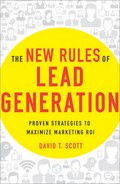8
Social Media
Advertising—Part I:
Facebook and LinkedIn
TO BEGIN with, I need to make a distinction of sorts: In this chapter, and in the next chapter, I will focus on social media advertising, which is a subset of social media itself. You should not confuse social media advertising—or “social advertising,” for short—with the use of social media as a customer engagement tool.
Social media has been around for over a decade; its origins go back to the online communities of the 1990s, such as Geocities and Tripod. But in the past few years, social media has become a full-fledged phenomenon, used by millions of people around the world. Many companies are now embracing social media as a useful tool to reach out to consumers. Advertisers and marketers use social media tools to generate buzz and activity about companies and their products and services. The most common tools used for marketing are blogs, Twitter, and social media sites like Facebook and LinkedIn.
For example, in social media, marketers make regular blog posts to keep their audiences in touch with the company and to drive traffic to the company’s website, thus increasing their organic ranks on the search engines. Companies use tweets to make special offers and announcements to their Twitter followers, and they post special offers to their Facebook Fans on the company’s Facebook page.
However, social advertising is a component of social media that is specifically designed for lead generation. In social media advertising, marketers post banner ads on social media sites in order to generate leads. These ads target potential customers with specific demographics, as defined by the social media users themselves. Companies pay for these ads on a PPC or CPM basis.
What’s the difference between social media and social advertising? Simply this: In social media, you are “preaching to the choir,” or at least to the congregation. The people who follow your blog posts, Facebook posts, Twitter feeds, etc., are already your leads or customers. They are your Facebook Fans, LinkedIn contacts, Twitter followers, blog followers, and other types of supporters. Even if they haven’t made a purchase from you yet, they know your company and have a definite interest in what you offer. You hope they will share your blog posts or Facebook posts or that they will retweet your Twitter tweets to other social media users.
In this chapter and the next one, I won’t talk about how to use blogs, company Facebook pages, or the social aspects of Twitter to generate leads (although some companies have used them for this purpose). In general, when you use Facebook posts, tweets, and blogs as social media, they are not traditional lead-generation tools. They are more like buzz-building tools, similar to public relations or word-of-mouth marketing.
But the purpose of lead-generation marketing is to acquire new leads, and that’s where social advertising comes in. In a social ad campaign, your ads will be posted to anyone on Facebook, LinkedIn, or Twitter who falls within the demographics you select. As a quick example, say you are a travel company and you post an ad on Facebook for Honeymoon Cruises. Your ad will be seen by Facebook users who list their marital status as “engaged.” Social advertising allows you to reach out to potential customers who are not already your Facebook Fans, LinkedIn contacts, or Twitter followers, and convert them into new leads or drive them to sales. The most popular social media sites—Facebook, LinkedIn, and even Twitter—have all embraced social advertising.
In this chapter, I will talk about Facebook and LinkedIn, which are Web-based social media networks. I’ll talk about the components that go into building a compelling lead-generation campaign on these two networks. I’ll also talk briefly about advertising on MySpace and other social media sites. In the next chapter, I’ll talk about Twitter, which is primarily a mobile-based social media network, and which has developed a slightly different model for social advertising.
